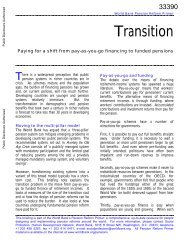Financial Sector Development in Africa: Opportunities ... - World Bank
Financial Sector Development in Africa: Opportunities ... - World Bank
Financial Sector Development in Africa: Opportunities ... - World Bank
Create successful ePaper yourself
Turn your PDF publications into a flip-book with our unique Google optimized e-Paper software.
168 Fuchs, Losse-Mueller, and Witte<br />
Figure 5.5 Year-on-Year Growth Rates of Credit to the Private <strong>Sector</strong> <strong>in</strong><br />
Sub-Saharan <strong>Africa</strong><br />
Percent<br />
40<br />
35<br />
30<br />
25<br />
20<br />
15<br />
10<br />
5<br />
0<br />
2006M01<br />
2006M05<br />
2006M09<br />
2007M01<br />
2007M05<br />
2007M09<br />
2008M01<br />
2008M05<br />
Year/Month<br />
Sub-Saharan <strong>Africa</strong>n average<br />
Sub-Saharan <strong>Africa</strong>n median<br />
2008M09<br />
2009M01<br />
2009M05<br />
2009M09<br />
2010M01<br />
2010M05<br />
Source: IMF’s International <strong>F<strong>in</strong>ancial</strong> Statistics database 2010.<br />
w<strong>in</strong>dfalls, peace dividends <strong>in</strong> postconflict situations, or donor bubbles)<br />
followed by busts <strong>in</strong>duced by <strong>in</strong>ternal or external shocks are not<br />
uncommon.<br />
The experience of various <strong>Africa</strong>n jurisdictions prior to the f<strong>in</strong>ancial<br />
crisis highlights the limitation of focus<strong>in</strong>g primarily on the ratio of credit<br />
to GDP. The more volatile macroeconomic environments put additional<br />
demands on decision makers.<br />
For example, <strong>in</strong> Ghana, Nigeria, and Zambia, high growth <strong>in</strong> private<br />
sector credit (above 30 percent) prior to the crisis was offset by<br />
commodity-driven GDP growth <strong>in</strong>flat<strong>in</strong>g the denom<strong>in</strong>ator. Additionally,<br />
economic development from a low base is likely to have a disproportionately<br />
high <strong>in</strong>itial trend trajectory. In Ghana, for example, credit to GDP<br />
has more than tripled <strong>in</strong> a decade, with nom<strong>in</strong>al credit growth frequently<br />
ris<strong>in</strong>g above 30 percent, but the ratio of credit to GDP rema<strong>in</strong>ed<br />
below the trend level <strong>in</strong> the years before the crisis. The high trend<br />
momentum was caused by fast growth from a low base of credit to GDP,<br />
and would make it more challeng<strong>in</strong>g for authorities to determ<strong>in</strong>e appropriate<br />
buffers (see figure 5.6). In low-<strong>in</strong>come countries <strong>in</strong> general, buffers<br />
would need to be triggered by also look<strong>in</strong>g at nom<strong>in</strong>al private sector<br />
growth.<br />
The implementation of such a countercyclical buffer regime poses<br />
significant challenges <strong>in</strong> build<strong>in</strong>g supervisory capacity and establish<strong>in</strong>g







